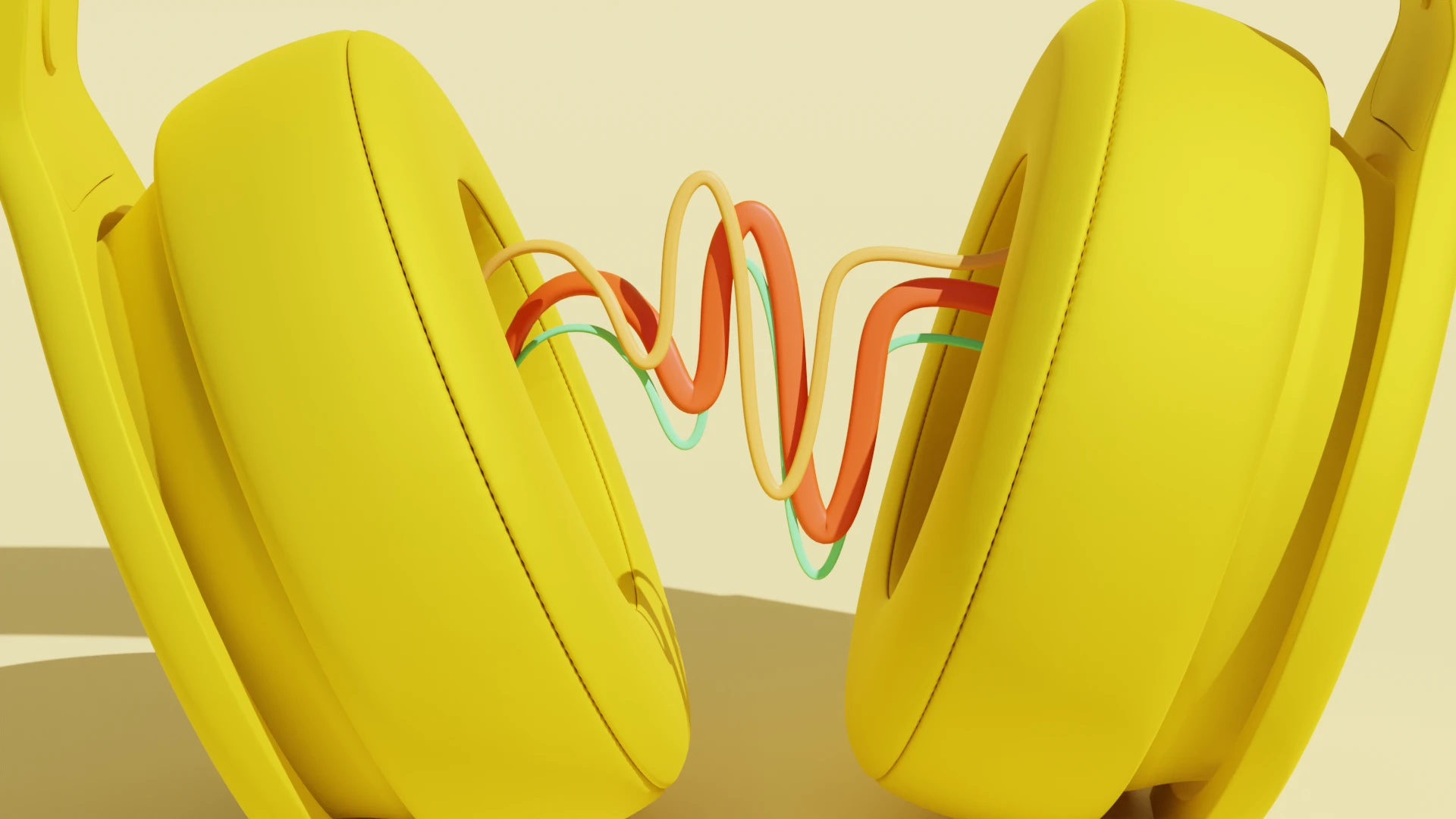Let’s face it: if you’ve ever tried recording straight into your laptop, phone, or tablet, the records usually sound a little…sad. Built-in mics pick up every hiss and hum. Your listeners deserve better. Luckily, a polished podcast mic doesn’t have to break the bank. In fact, with a humble $100 mic and Descript’s Studio Sound, you can sound like you sprang for the top-shelf gear.
Below we break down the important considerations for choosing a mic. But if you’d rather just get right to our picks, here you go.
The best budget-friendly podcast mics
In terms of great mics for podcasts that cost $100 or less, here are six models to consider:
- Shure SM58. The Shure SM58 isn’t just one of the best mics under $100 — it’s one of the best mics, period. What makes these particular XLR mics so beloved? Their neutrality and durability. They provide an accurate representation of just about any speaker, singer, or instrument — nothing sounds artificially enhanced or distorted. And they can survive all kinds of abuse (though you, of course, should treat them with care). These are great mics for podcasts or just about anything else. The SM58 currently costs $99, and Shure hasn’t changed the price for decades.
- Sennheiser E 845-S. The E 845-S Dynamic Super Cardioid Microphone is German-based Sennheiser’s answer to the SM58; both use XLR connections and both sell for $99. One advantage the E 845-S offers is an on/off switch on the microphone that instantly cuts audio. Like the SM58, the E 845-S has a rugged, all-metal construction, which you can use and abuse without compromising functionality.
- Blue Yeti.The Blue Yeti regularly tops the list of best USB microphones for podcasting, and with good reason. It’s a large-diaphragm condenser mic, and it draws power through its USB mic cable. It can do multiple pickup patterns including cardioid, omnidirectional, bidirectional, and stereo. It also comes with its own tabletop mount, but you can also place it on a traditional shock mount with a microphone stand. The Blue Yeti is somewhat heavy, so be sure to use a mic stand with a weighted base. The base model Blue Yeti sells for $99.
- Røde PodMic. Australian-based Røde has built its name by combining stellar sound quality with fair prices. The PodMic is no exception and is specifically built for podcasting. It’s an XLR microphone, which means you’ll need an audio interface to use it with your computer or tablet. The PodMic has an internal pop filter and an internal shock mount to cut down plosives (the kinds of sounds usually associated with the letters p, t, k, b, d, and g) and jolts, respectively, that can sometimes sully podcast recordings. It retails for just under $100.
- Samson Q2U. Often called a "best of both worlds" mic for entry-level podcasters, the Q2U features both USB and XLR outputs for flexibility. It’s durable, rejects background noise well, and is easy to set up — ideal for anyone starting out.
Technical specs for choosing a mic
As you search for the perfect mic for your podcasting needs, you’ll find boundless options. To match your microphone with the right use case, keep the following technical considerations in mind:
Mic types
You have three choices when selecting a mic: Dynamic, condenser, or ribbon. You can maximize your budget by going for a dynamic mic or condenser mic. Here’s how they differ:
- Dynamic microphone. Dynamic mics use magnetic fields to generate audio signals. The force of air causes a tiny metal coil suspended within the mic to move, creating an electrical current that transmits the audio. Dynamic mics tend to be the most affordable; you can get a high-quality model for little money.
- Condenser microphone. A condenser mic uses capacitance — a change in electrical voltage — to create audio signals. Compared to dynamic mics, condensers tend to be more sensitive, picking up audio nuances like breaths, as well as extremely high and low frequencies. They’re also more fragile, and require external electrical current, known as phantom power, to work.
- Ribbon microphone.
It’s true you can find a new ribbon microphone under $100. However, most of these budget models are underwhelming. Ribbon designs require careful craftsmanship to capture sound accurately, which drives up their price.
If you’re set on owning a ribbon mic at a low cost, consider buying a second-hand unit or look for refurb deals. But for most podcasters, a dynamic or condenser mic is a better first step.
Pickup patterns
A microphone’s pickup pattern describes its ability to record sound sources from various directions. Here are the four main patterns:
- Cardioid. Cardioid is a common directional pattern that appears in dynamic, condenser, and ribbon mics alike. The pickup pattern looks a bit like a heart, with the heart’s indentation located just behind the mic, giving it high sensitivity to sound in front of the mic capsule, slightly reduced sensitivity from the sides, and almost no sensitivity from behind. There are two variations of the cardioid polar pattern: super cardioid, which is like cardioid but with more sensitivity behind the microphone; and hyper cardioid, which covers more sound sources behind the mic.
- Omnidirectional. An omnidirectional mic captures sound from all directions. These are not the best microphones for podcasting because they can’t focus on a single speaker, and they may pick up too much background noise.
- Bi-directional. Bi-directional mics capture an equal amount of sound in front of and behind the mic.
- Shotgun. Shotgun mics capture a narrow band of sound in front of and behind the microphone and are mostly used in video production.
Connectivity
Mics connect to recording devices via XLR, USB, or Bluetooth, and connectivity can affect recording quality. Here’s how these types of connections differ:
- XLR connection. XLR microphones have three-prong ports at their base that connect to a balanced XLR cable. This type of connection minimizes line noise caused by electrical interference and cuts diminished frequencies that sometimes occur over long cable runs, and is the industry standard for professional audio equipment. XLR mics can therefore connect to almost any mixer or digital audio interface. You’ll need that digital audio interface to use an XLR mic with a laptop since XLR cables can’t plug right into computers.
- USB connection. USB mics plug directly into your device’s USB ports, using the same USB cables that connect phones and printers to, say, computers. The problem is they can’t plug into much else, and most USB mics can’t match the audio quality of XLR mics. Yet if you’ll specifically use your USB mic for podcasting, brands like Blue have issued affordable models that combine great sound with USB connectivity. Note that if you’re plugging directly into an iPhone or older-model iPads, you’ll need a mic that uses Apple’s proprietary Lightning plug.
- Bluetooth connection. You can also find Bluetooth mics for less than $100 — but approach these with caution. The Bluetooth standard compresses audio, reducing sound quality, which is why they’re rarely used for studio recording.
Five tips to make your mic last longer
Once you’ve invested in a mic, you’ll want to keep it functional for as long as possible. A little TLC can go a long way. Here are five tips to help keep your mic working:
- Avoid extreme temperatures. Microphones are not designed for extreme heat. When left in a scorching environment, like in a hot car, some mics can suffer internal damage from melting wires. Unfortunately, a lot of sub-$100 dollar mics have low-budget wires and poor soldering jobs, so you have to be careful about where you leave them.
- Invest in a good mic stand. You don’t want to drop your mic. At the very least, you’ll damage its grille, which can hurt resale value (even if it doesn’t harm the functionality of a rugged mic like the Shure SM58 or the Sennheiser E 845-S). But with a fragile condenser mic, you can dislodge a condenser capsule, rendering the mic useless. The best way to avoid dropping your microphone is to keep it on a sturdy stand. High-quality stands can be expensive, but they pay for themselves given the protection they provide.
- Put your mics away. Some microphones come with cases, but most low-budget units don’t. If you value your microphone and want it to last, invest a few extra dollars in a case — or at least a pouch — to store it when not in use.
- Cover your mic. You might want to leave your podcast mic set up at all times so you can record at a moment’s notice. This is fine, provided that the microphone has a cover. Ambient dust can interfere with the internal components of your mic, so keep yours covered when not in use.
- Watch out for humidity. When it comes to electronic equipment like microphones, moisture is never your friend. Mics should stay dry. An easy solution is to put silica packets in your mic cases. They absorb excess humidity and keep your mics working as intended. This is particularly important if you live in a notably humid environment.
Frequently asked questions
Are dynamic or condenser microphones better under $100 for podcasting?
Both types can work well under $100, but dynamic microphones usually pick up less room noise, which helps if you’re recording in a space without sound treatment. Condenser mics provide more detailed sound but may capture extra background noise. Pick what fits your recording setup best, and consider using noise-reduction tools if you go with a condenser.
Which sub-$100 microphone is popular with first-time podcasters?
The Samson Q2U stands out because it offers decent sound quality and both USB and XLR connections, so you can plug it straight into a computer or expand to a mixer later. It’s known for being beginner-friendly without sacrificing crisp audio.
Can I reduce background noise on a budget microphone?
Yes. Position the mic close to your mouth, use a pop filter or foam screen, and record in a quiet room when possible. You can also edit out ambient sounds later with software like Descript’s Studio Sound, which helps soften noise and echo.
Does Descript help improve audio from sub-$100 mics?
Absolutely. Descript’s Studio Sound uses AI to remove hiss, room echo, or other rough edges that come with inexpensive gear. Upload your track, enable Studio Sound, and it’ll polish your recording so it sounds more like it was made in a pro studio.






































.jpg)





